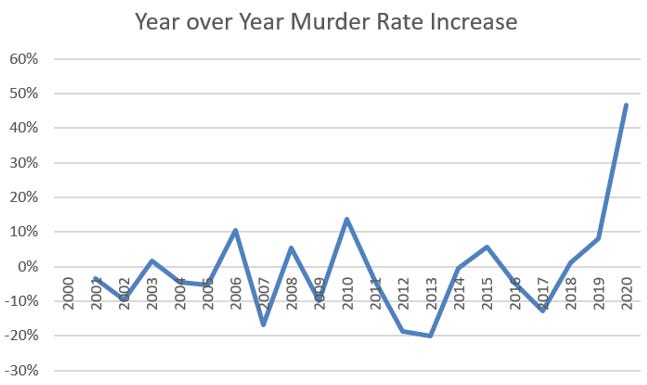Happy Valentine’s Day! (And Happy Post-Super Bowl Monday). I hope you are all taking a little break from seriousness to enjoy some nice wine or a decent movie.
Given that we New Yorkers are probably already riled up at this early hour after a few scrolls down Twitter Lane, your evening conversation will likely focus on the hot topic of the day to spice up your night. What is a hotter topic than crime?
A Quinnipiac poll released last week expressed discouraging public sentiment. 74% of registered NYC voters believe that crime is a very serious problem in the city, and 46% of registered voters believe crime is the most urgent issue.
You don’t need a data model to predict how partisan actors have responded to this sentiment. There are those who blame the policies of past and present. There also are those who attribute the “hysteria” as a manifestation of the media. How can so many people be so confident they are right?
To sort this out, I looked at NYPD murder data. Not only are murders a heinous act against humanity (they do result with someone dead), but unlike other horrible crimes, the expectation is that most murders get reported and the cases get prioritized. This is the clearest data we can look at.
Let’s first take a look at the differences in murders year-over-year
In 2020, the number of murders in New York City rose 47% compared to 2019. Only twice this century have we seen a year-over-year rise greater than 10%. Chicken Little said the sky is falling, and he was right…
…or was he? When we look at the number of murders by year, we see a completely different story.
There was a big increase in 2020, but in absolute terms, the number of murders is still lower than it was 10, and even 20, years ago. If we normalize this number on a per capita basis, New York City does not even rank on the FBI’s top 50 metropolitan area murder rate list.
Even if you have not read a chapter of Daniel Kahneman’s Thinking, Fast and Slow, it becomes clear why NYC can feel dangerous and safe at the same time. One of the key components of behavioral economics is how humans naturally (but not always rationally) come up with reference points which we use as a comparison base. We are also susceptible to recency bias, where we overweight new information over old. If we overweight new information, this means our reference point is weighted more heavily towards the last 10 years, or a time when NYC was relatively safer. This explains why 74% of us feel crime is a problem even though the level of crime is low compared to NYC’s history.
Should we feel safe or unsafe? Is crime a problem? Or, what many politicians and talking heads are really interested in, who is right?
Should we feel safe? We should feel nearly as safe as we usually have. There are normal risks of living in a city, but NYC is one of the safest cities in the United States today. If you don’t feel safe here, then you likely should not feel safe in most metropolitan areas.
Is crime a problem? Such a large spike is not necessarily a huge problem today, but the concern is legitimate and does deserve attention, especially as this trend continues past 2020.
Who is right? The resolution might not be as simple as finger pointing or quick fixes such attributing it all to bail reform or lack of preventative resources.
Since nothing will get resolved tonight, I hope you enjoy your evening and eat something tasty.
To subscribe to future or check out past newsletters, click here.
For more content, follow 2xParked on Twitter @2xParked.
Comments? Suggestions? Questions? Email me at 2xParked@gmail.com.




